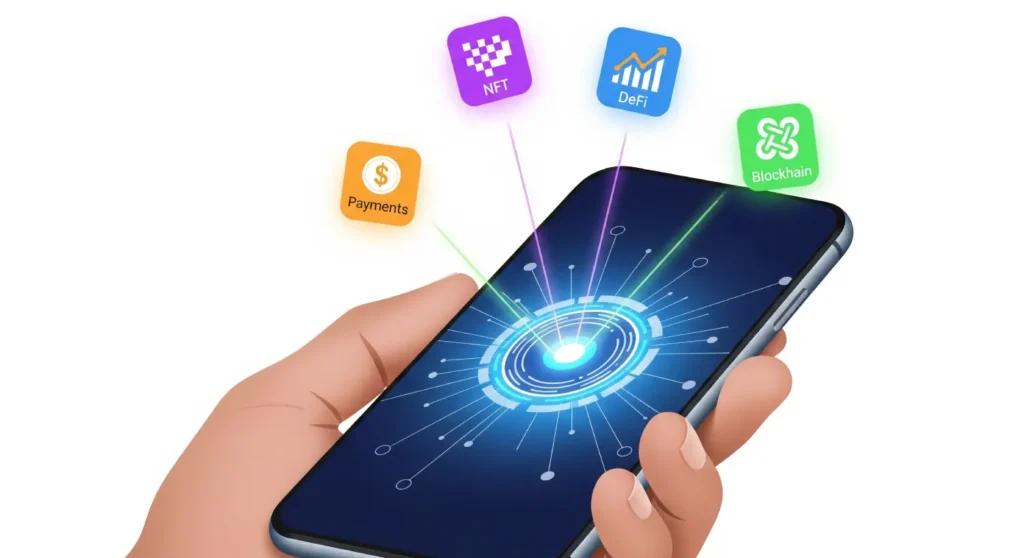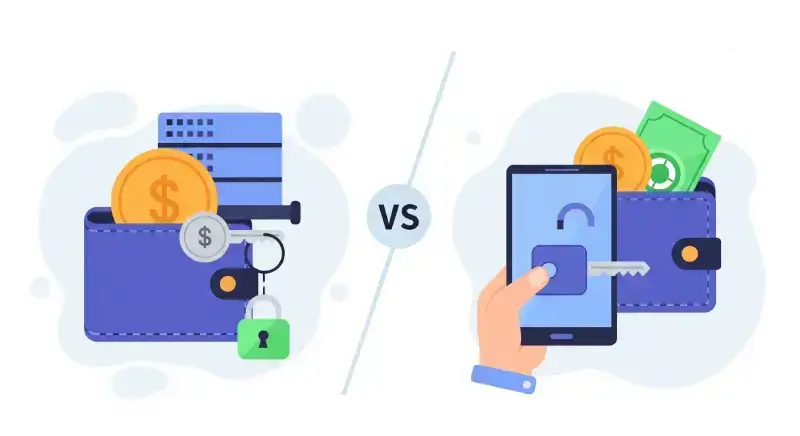
Ready to Take Your Crypto on the Go?
A mobile crypto wallet is a powerful tool for managing digital assets on the go. This type of crypto wallet app allows users to store, send, and receive cryptocurrencies directly from their smartphones. As the crypto market has grown, these wallets have become an essential part of the ecosystem for many individuals.
The popularity of mobile wallets is driven by their convenience and accessibility. They allow for quick transactions and easy portfolio management from almost anywhere. However, ensuring crypto wallet safety is crucial.
This guide will explore the features and practices that make a secure mobile wallet a reliable choice for everyday crypto use.
📌 Key Takeaways
- ✅ Mobile wallets are “hot” wallets: Their constant internet connection makes them convenient for on-the-go use but also more vulnerable to mobile malware and risks from public Wi-Fi.
- ✅ Your gateway to Web3: Mobile crypto wallet is more than just a place to store assets; it’s a key to decentralized apps, NFTs, and managing your digital identity.
- ✅ Device security is your first line of defense: Since your wallet is on your phone, securing the device itself with biometrics and a strong PIN is essential to protect your assets.
- ✅ You are responsible for your private keys: Mobile wallets are typically non-custodial, so your seed phrase is the only way to recover your funds if your phone is lost or damaged.
- ✅ Download from official sources only: Always get your wallet app from verified stores and keep it updated to protect against vulnerabilities.
1. What is a Mobile Crypto Wallet?
A mobile crypto wallet is a software application designed for your phone. It serves as a digital gateway to your cryptocurrency holdings on the blockchain. The purpose of a crypto wallet app is to store your cryptographic keys and allow you to interact with your funds easily. If you want to learn more about this concept, read What is a crypto wallet?.
A key distinction when discussing crypto wallets is whether they are “hot” or “cold” wallets. A mobile wallet is classified as a “hot” wallet 🔥 because it remains connected to the internet. Conversely, a hardware wallet is a “cold” wallet that stores your keys offline, offering a different approach to digital asset management. For a more in-depth understanding of this difference, check out our article Hardware vs. Software Wallet.
2. Advantages of Mobile Crypto Wallets
Mobile crypto wallets offer a range of benefits that make them appealing for many users. Their design focuses on making crypto management as seamless as possible. This section will explore some of the key reasons people choose to use a mobile wallet for their digital assets.
- User-friendly accessibility: You can manage your portfolio and conduct transactions from almost anywhere, if your phone is with you. This makes crypto use highly flexible.
- Intuitive usability: Most wallets are designed with clear interfaces that simplify the process of sending, receiving, and monitoring various cryptocurrencies. This focus on design helps a wider audience engage with crypto.
- Functional security features: Wallets often include robust features like PINs, biometric authentication, and two-factor authentication to protect your assets. These layers of defense are essential for maintaining control over your keys.
- Support for multiple cryptocurrencies: 🪙 Many wallet applications support a wide array of tokens and coins on different networks. While this feature is not unique to mobile wallets, it allows you to manage a diverse crypto portfolio within a single, unified application on the go, which is a key advantage.
- Connectivity with DeFi platforms: 🔗 These wallets can often be linked directly to decentralized finance (DeFi) applications and decentralized exchanges (DEXs). If you want to learn more about DeFi, read What is DeFi?. This integration lets you participate in staking, lending, and other DeFi activities with ease.
- Portfolio tracking features: 📈 Most mobile crypto wallets include built-in tools for monitoring your asset performance. You can view real-time price updates and see a breakdown of your holdings, which assists in managing your investments.
3. Choosing a Mobile Crypto Wallet
Selecting a crypto wallet app involves several considerations to ensure your assets are protected and accessible. The decision depends on your personal needs, suchs as the types of cryptocurrencies you hold and your level of comfort with technology. Evaluating different options carefully is an important step in your crypto journey.
Here are some key criteria to consider:
- Security: 🛡️ Look for wallets that offer robust features like biometric logins and private key encryption. A secure mobile wallet puts control of your private keys in your hands, which is a key aspect of crypto wallet safety.
- Custodial vs. Non-Custodial: This is an important factor to consider. With a non-custodial wallet, you retain full ownership and control of your private keys. In contrast, a custodial wallet holds your keys on your behalf, which can offer simplicity but means you rely on a third party. For a detailed breakdown of this, check out Custodial vs. Non-Custodial Wallet.
- Supported Coins: 🪙 Check if the wallet supports all the cryptocurrencies you plan to use. Some wallets are designed for specific coins, while others support a broad range of tokens across multiple blockchain networks.
- User Interface: 🖥️ A clean and straightforward interface can make managing your assets much easier. A good design helps you navigate features like sending, receiving, and monitoring your portfolio without unnecessary complications.
- Backup Options: 🔑 Ensure the wallet provides a clear and reliable method for backing up your seed phrase. This phrase is the only way to recover your funds if your device is lost or damaged.
Consider researching different platforms to find a mobile crypto wallet that aligns with your specific requirements.
4. Securing Your Mobile Crypto Wallet
Even with a reliable mobile crypto wallet, personal security practices are crucial for protecting your assets. Taking proactive steps can help you avoid common pitfalls and keep your digital funds safe. A secure mobile wallet is only as strong as the habits of its user. For more information on security, read What is Crypto Security?.
Here are some essential tips for crypto wallet safety:
- Protect your private keys and seed phrases: 📝 Your seed phrase is the master key to your wallet, so never share it with anyone. Store it offline in a secure, private location where it cannot be accessed digitally.
- Use two-factor authentication (2FA): 🔒 Enable 2FA whenever possible to add a layer of security to your wallet and other crypto accounts. This requires a second form of verification, making it harder for unauthorized users to gain access.
- Be cautious of phishing attempts: 🎣 Always verify the source of links and requests before interacting with them. Only download a crypto wallet app from official app stores to avoid malicious software.
- Regularly update your wallet app: 🔄 Developers frequently release updates that include security patches and bug fixes. Keeping your wallet software current helps protect you from known vulnerabilities.
- Create secure backups: 💾 In addition to your seed phrase, consider creating encrypted backups of your wallet. This provides a way to restore your funds in case of device failure, but always handle these backups with care.
For a checklist on crypto security for beginners, read How to Secure Crypto for Beginners.
5. Setting Up a Mobile Crypto Wallet
Getting started with a mobile crypto wallet is a straightforward process. The steps typically involve downloading the application and following a few key security measures. This initial setup is a critical point for ensuring long-term crypto wallet safety.
Here’s how to get started:
- Download a reliable wallet app: 📲 Go to the official app store for your device and search for your chosen wallet.
- Create your account and security setup: ✅ The app will guide you through creating a password or PIN. You will then be prompted to create and securely back up your seed phrase, which is a collection of words that serves as your wallet’s recovery key.
- Transfer cryptocurrencies to the wallet: ➡️ Once your wallet is set up, you can transfer funds by copying your wallet’s public address. Paste this address into the “send” field of another exchange or wallet to move your crypto.
- Conduct transactions: 🛒 To send crypto, select the asset you wish to send and enter the recipient’s public address and the amount. To receive crypto, simply share your wallet’s public address with the sender.
6. Uses of Mobile Crypto Wallets
Mobile crypto wallets serve many purposes beyond just storing funds. Their connectivity and design allow users to engage with the broader crypto ecosystem. These applications have become a central point for various activities.
Here are some common ways to use your wallet:
- Everyday payments and transfers: 💸 You can use your wallet to pay for goods and services in places that accept crypto. This functionality also makes it easy to send funds to friends and family across the globe.
- Staking for rewards: 💰 Some wallets offer direct staking features for supported proof-of-stake cryptocurrencies. This allows you to earn passive income by locking up your assets to help secure a blockchain network.
- Trading on decentralized exchanges (DEXs): 🔄 Many wallets can connect directly to DEXs, enabling you to trade tokens without a centralized intermediary. This is a key feature for accessing a wider range of assets and participating in DeFi.
- Managing NFTs and digital assets: 🖼️ A mobile crypto wallet is often used to store and display non-fungible tokens (NFTs). You can view your digital collectibles and even participate in NFT markets directly from the app.
7. Risks of Mobile Crypto Wallets
While a mobile crypto wallet offers significant convenience, it also has specific risks tied to the mobile platform. Being aware of these potential issues is a key part of responsible crypto management. A secure mobile wallet requires vigilance beyond its built-in features.
Here are some of the platform-specific risks to consider:
- Device theft or loss: 📱 Losing your physical phone means someone could attempt to access your wallet. This highlights the importance of using strong device-level security, such as biometric unlocks and PINs, to prevent unauthorized entry.
- Mobile malware and app vulnerabilities: 🦠 Malicious software on your phone could attempt to steal your data, including private keys. To mitigate this risk, install a crypto wallet app only from official app stores and avoid clicking on suspicious links. You can find useful tips for protecting your mobile device from malware and scams in this consumer cybersecurity checklist from CISA.
- Unsecured public Wi-Fi networks: 📶 Using a mobile crypto wallet on a public Wi-Fi network can expose your data to potential eavesdropping. It is a good practice to use a secure connection or a VPN when conducting transactions.
- Compromised operating systems: 🔓 Devices with modified operating systems (e.g., jailbroken or rooted phones) are more susceptible to attacks. These modifications can bypass the security features of the OS, putting your wallet at greater risk.
8. Trends in Mobile Crypto Wallets
The world of mobile crypto wallets is continuously evolving, with new features and integrations appearing regularly. Developers are focused on improving security, usability, and connectivity to support the growing crypto ecosystem. These trends point to a future where managing digital assets becomes even more accessible.
Key trends include:
- Advanced security features: 🔑 Wallets are increasingly incorporating biometric authentication, like fingerprint or facial recognition, for more seamless and secure access. This technology adds a strong layer of defense for a secure mobile wallet.
- Integration with Web3 and decentralized apps (dApps): 🌐 Modern wallets are designed to connect directly with Web3 applications, making it easier to interact with decentralized services. This integration allows users to participate in the broader decentralized internet.
- Cross-chain support: ⛓️ Wallets are expanding to support a wider range of blockchain networks, allowing users to manage assets from different ecosystems within a single application. This reduces the need for multiple wallets and simplifies portfolio management.
- Improved user interfaces: 🎨 Developers are focusing on intuitive, user-centric design to make the experience of using a crypto wallet app more engaging. Clearer interfaces and simplified workflows help new users get started with crypto.
9. Frequently Asked Questions
Q1: 🤔 What is the difference between a mobile wallet and a hardware wallet?
A: A mobile wallet is a “hot” wallet, meaning it is connected to the internet and stores your keys on your phone. A hardware wallet is a “cold” wallet; it is an offline device that stores your keys, offering a different level of security.
Q2: 💰 Can I use one mobile wallet for all my cryptocurrencies?
A: Yes, many modern mobile wallets are multi-chain and can support a wide variety of cryptocurrencies. However, you should check the wallet’s specifications to confirm that it supports the specific coins you plan to use.
Q3: ❓ What happens if I lose my phone?
A: If you lose your phone, you can restore your wallet on a new device using your seed phrase. This is why keeping your seed phrase in a secure, offline location is crucial. Without it, you may lose access to your funds.
Q4: 📶 Is it safe to use my mobile crypto wallet on public Wi-Fi?
A: It is generally not advisable to use your wallet on unsecured public Wi-Fi networks. This can expose your data to potential risks. Using a secure connection is a good practice when conducting transactions.
🎯 Conclusion
A mobile crypto wallet is an essential tool for anyone looking to engage with the digital asset economy. It provides a convenient way to manage funds, conduct transactions, and participate in the wider crypto ecosystem from your phone. Understanding the features and security practices is vital for a positive experience.
By selecting a reliable secure mobile wallet and following careful habits, you can take control of your financial freedom. A crypto wallet app can be a powerful gateway to the world of decentralized finance and digital assets. Taking the time to choose a suitable wallet and protect it properly is a valuable investment in your financial security.
📘 Ready to deepen your knowledge? 👉 Explore our next guide: How to Get Started with Crypto.

